How to Hit Iron Shots in Golf
Do You REALLY Know How to Hit Irons? Find Out Which Classic Iron Tips are Actually Destroying Your Golf Game.
Most golfers have received plenty advice for how to hit irons. Which means if you’re reading this article, the advice you’ve heard isn’t working.
Don’t worry. It’s not just you. Many amateur golfers know the anguish of doing their best to follow popular golf tips only to see zero results. It’s disheartening. But it doesn’t mean there’s no hope for a better golf game.
It just means you’ve gotten bad advice.
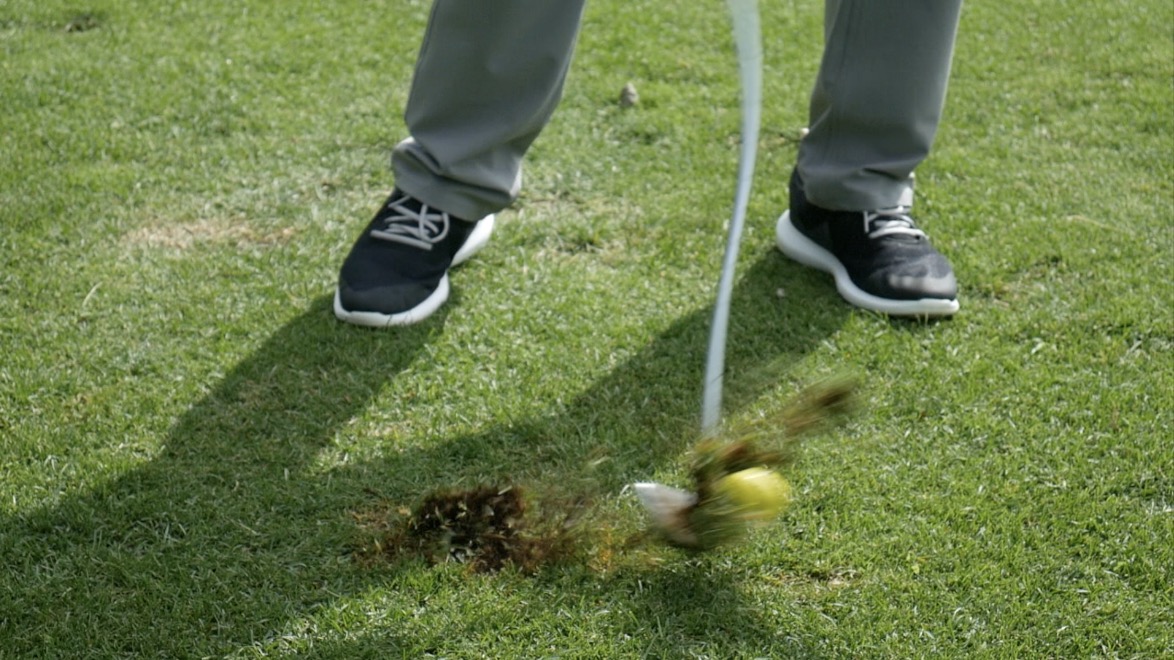
You are about to learn how to hit irons starting with some basic concepts and ending with a few corrections to the tips you’ve been using the play the game. By the time we’re through, you’ll know how to hit crisp, solid iron shots every single time.
Let’s start with the basics.
Iron Play: An Overview
Before you can understand how to hit irons, you have to understand what an iron shot is.
Of course you know it’s a golf shot you make with a golf iron. But do you know what sets these long(ish)-distance shots apart from that other long distance shot—the drive?
Irons vs Drivers
We have a lot of videos and articles on the differences between hitting irons vs drivers, so check those out if you’d like a more in-depth look at these different swing motions.
For now, I’ll give you the broad overview. It’s very simple.
You want to hit up on your driver and down on your irons.
What does this mean?
Think of the shape your club head makes as you swing through the golf ball. As you move through the transition at the top of your swing, towards the ball, the club head is traveling at a downward angle.
At some point (more specifically, at the low point), your club head changes direction. It starts traveling at an upward angle.
When you take a shot with your driver, you should make contact with the golf ball after the low point of your swing. You want to catch the ball just as the club head begins to ascend.
That’s what we mean when we say you hit up on your driver. And it’s easy to remember because you tee the ball up for those driver shots. It just makes sense.
For pure iron shots, however, the goal is to hit down on the golf ball. Another way to say this is that your moment of impact should occur before the low point of your golf swing.
It’s important to make this distinction when discussing how to hit irons because this whole down/up thing trips up a lot of golfers. Most weekend warriors are very good at either driver shots or iron shots, but they haven’t mastered both. And the reason is simple.
They’re using the exact same swing for both shots.
If you’re struggling with your iron shot, the problem could be that you’re not hitting down. Here’s a quick-and-easy checklist to fix that problem.
To Hit Down on the Golf Ball:
- At setup, position the ball in the center of your stance.
- Shift your hands toward the target just slightly so the club is in front of the club head.
- In the transition, think about pulling on the club with your lead hand instead of throwing the club out and down with the trail hand.
These simple moves set you up to hit down on the golf ball every time.
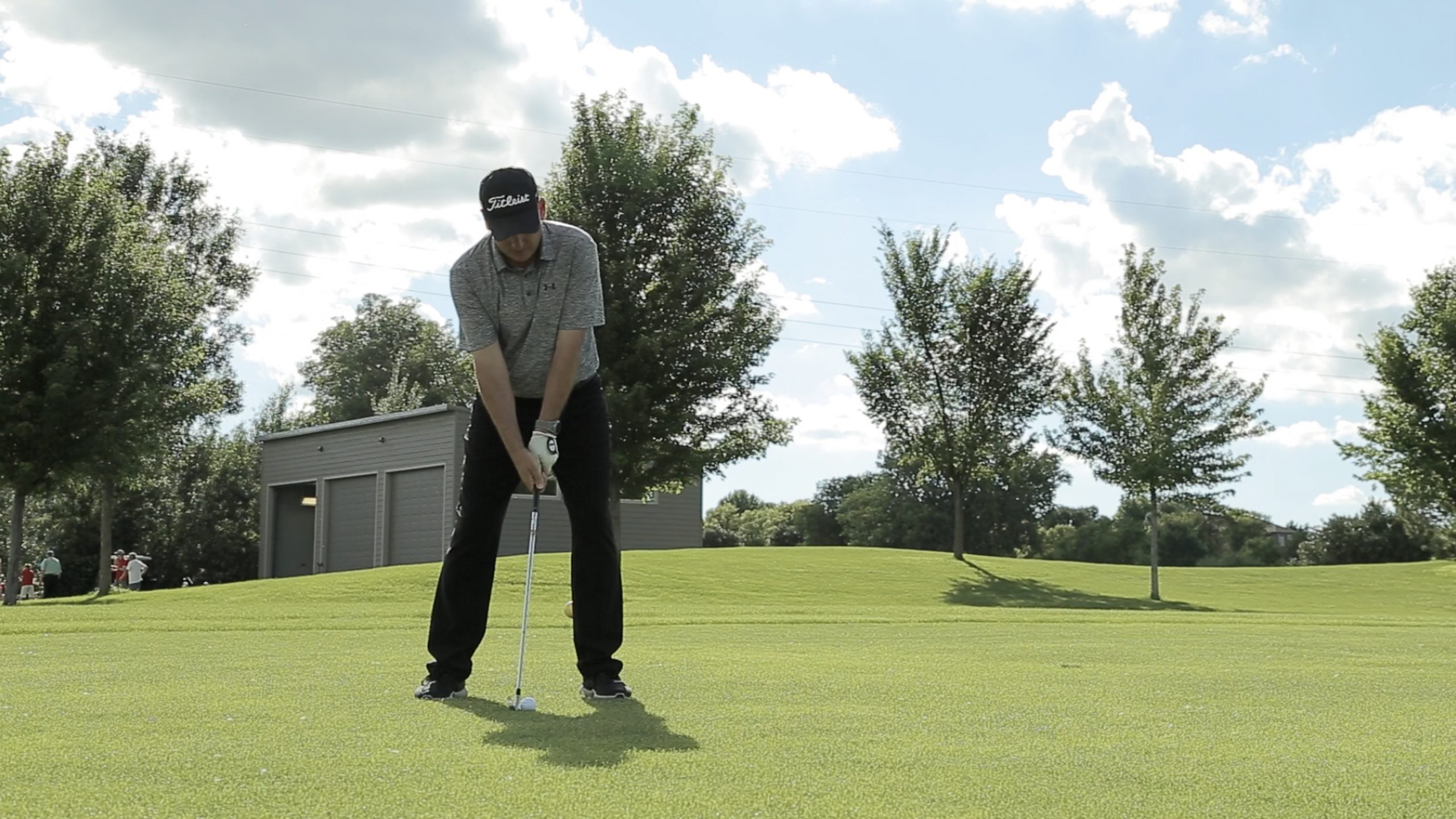
Do You Hit All Irons the Same Way?
Another important distinction between your driver and your irons is that you just have one driver. It’s true that you can choose between a longer shaft or a shorter shaft for your driver. But ultimately, you wind up with one option in your bag.
Irons, on the other hand, come in a few different lengths with different lofts.
So, do you have to handle each type of iron differently? Let’s take a look.
How to Hit Irons: Long vs Short
First, make sure you know which irons are considered “long” and which are “short.”
- Your long irons (2, 3 and 4) have a lower loft and are designed for more distance. (1 irons if you have them)
- Short irons (8, 9 and pitching wedge) have a higher loft and help you pop the ball up in the air as you get closer to the green.
- And your middle irons (5, 6 and 7) are, well . . . in the middle.
Now, as for the differences in hitting shorter irons versus longer irons, the most important distinction is in ball position. As you learn how to hit irons, you want to always note where the golf ball is in relation to:
- The feet
- Your hands
- The club shaft
And the correct position varies slightly depending on whether you’re using a long iron or a short iron. Let’s break this down.
Ball Position for Short Irons
When using a short iron, make sure the ball is positioned in the center of your golf stance. In other words, it should be centered between your feet.
To make sure you have it right:
- Stand with your feet together.
- Position the golf ball so it is aligned with the center of your stance.
- Step your lead foot towards the target and your trail foot away from the target and equal distance.
- The ball should now be centered in your stance.
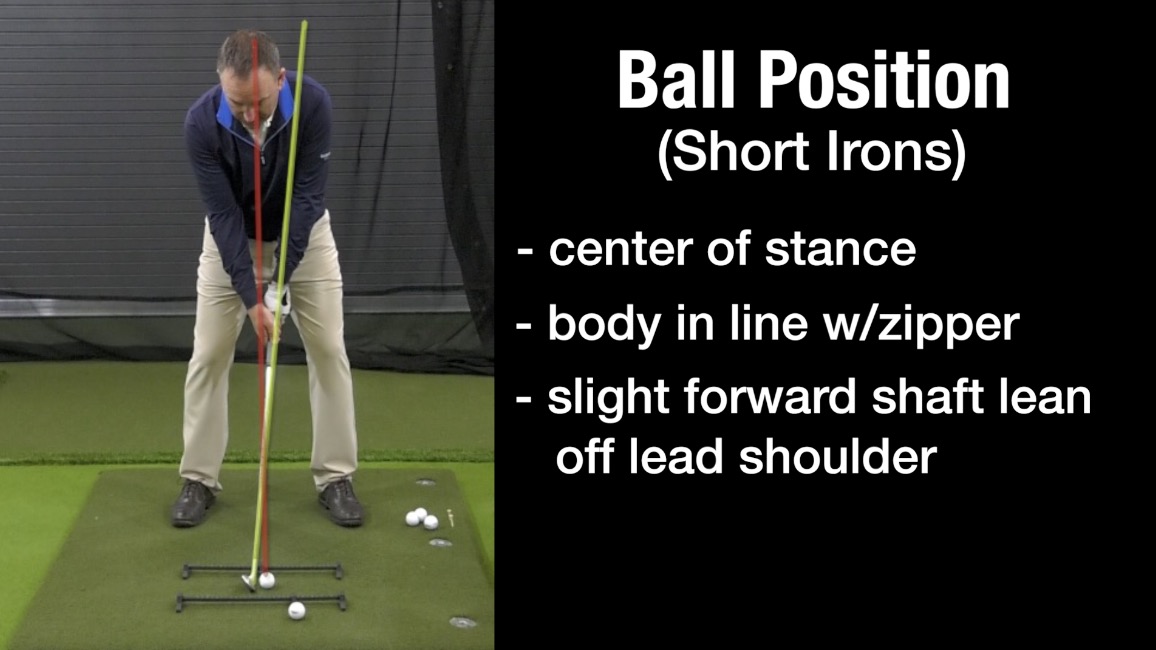
As for the golf ball’s position in relation to your body, you want the ball to line up with one of the following:
- The inner corner of your lead eye
- The buttons or zipper on your golf shirt
- Slightly forward of your nose
And finally, our third consideration: where is the ball in relation to the golf club? In other words, how does the club shaft line up with ball position? Ideally, the shaft is slightly in front of the ball. You might recognize this tip from the checklist for hitting down on the ball.
Now, let’s look at longer irons.
Ball Position for Long Irons
First, let’s talk feet. When you’re swinging a long iron, your goal is still to hit down on the golf ball. However, you don’t want your angle of attack to be as steep as it is when you’re hitting a short iron.
In order to avoid that steepness, position the ball just slightly forward of center. But don’t go as far forward as you would for a driver shot. Try following these steps:
- Stand with your feet together, the ball aligned with the space between your feet.
- Step your lead foot towards the target, but make that step slightly smaller than you would if you were setting up your stance for a short iron.
- Take a step away from the target with your trail foot. This step should be just a little bit bigger than the step you took with your lead foot.
- Check your golf ball. Does it appear to be just slightly forward of center?
As for golf ball position in relation to your body, a long iron shot calls for a slight tilt away from the target. The golf ball should align with one of the following:
- The logo on your golf shirt
- Your lead ear
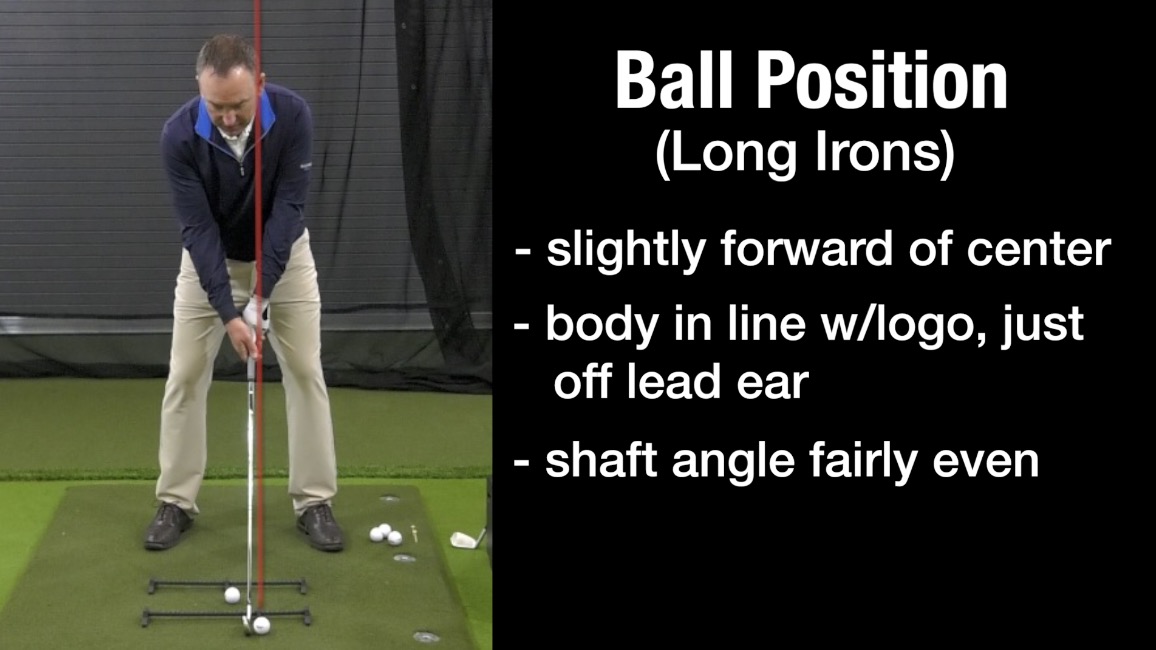
Finally, check where the golf ball is in relation to your club shaft. This standard is the same for both short irons and long irons. You want the shaft slightly in front of the ball.
So, you understand the ultimate goal of iron shots—to hit down on the golf ball. You know the difference between setting up shots for long irons versus short irons.
Now let’s get into the fun stuff. Let’s talk about why all that advice on how to hit irons has completely failed to improve your time on the the golf course.
Popular Myths About How to Hit Irons
I’m going to debunk three myths about how to hit irons. As I do, you’ll quickly notice that all three of these popular tips create the same problem.
They create tension in your golf swing.
Tension limits your mobility. It makes it more difficult to stay on the proper swing plane. Worst of all, it hurts. The classic advice about how to hit irons is bad advice for all golfers, but especially for those of us who are more . . . let’s say “experienced.”
With time, you lose flexibility. This means you lose mobility. The absolute last thing you need is muscle tension that interferes with your range of motion and puts you at risk for injury.
Here are the three tips you need to drop and what to do instead.
Myth #1: Keep Your Head Down
This isn’t just one of the worst tips for how to hit irons; it’s one of the all-time worst tips in golf.
But you still hear it all the time. If a golfer regularly tops the golf ball, someone is bound to tell them to keep their head down. Even great golf instructors say this. But it doesn’t help anything.
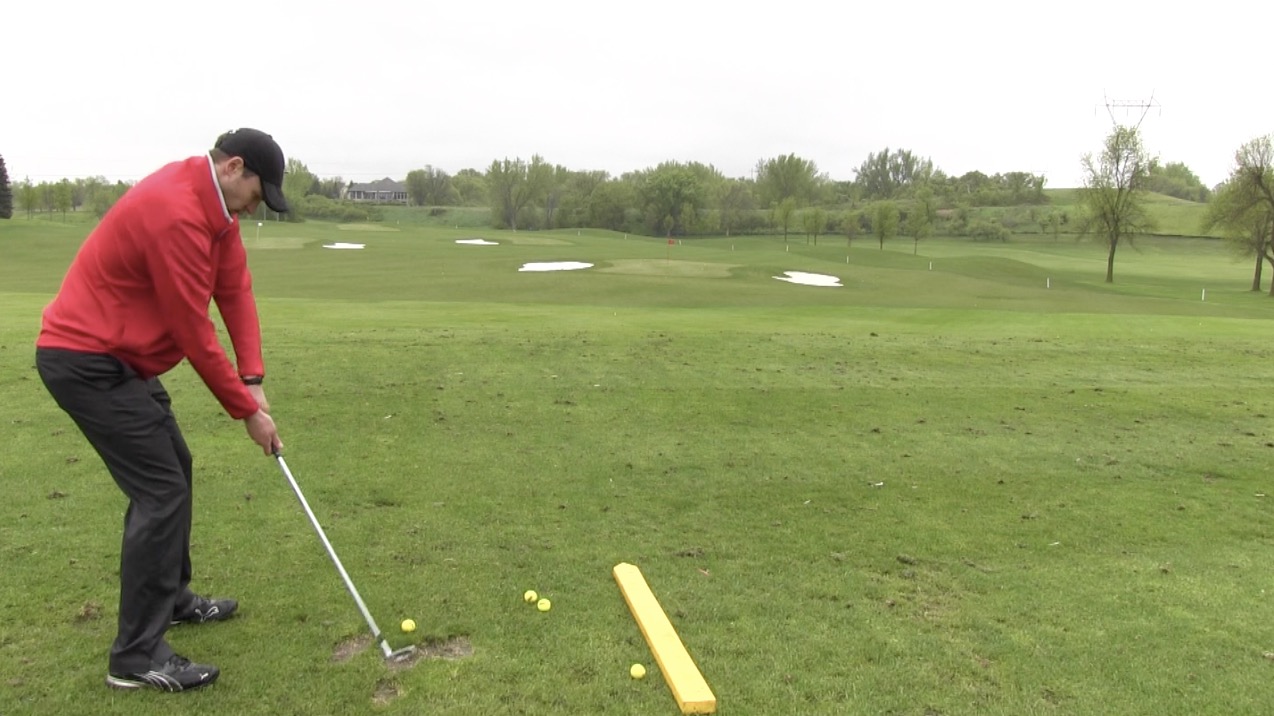
When you keep your head down, you create tension through your shoulders. It becomes very difficult to get the rotation you need in your golf swing. Remember: swinging a golf club is an athletic movement. You need to be loose and mobile.
I like to use the LiveView camera to help my students see how keeping their head down looks in their golf swing. (The replay feature is great for this.) Sure enough, when these golfers watch themselves, they see how rigid and stiff their swing is.
“Rigid and stiff” is not what you want to see when your goal is to generate speed and maintain control.
Do This Instead
As you take your golf setup, allow your head to float up a bit instead of tucking your chin close to your chest. Stay relaxed in the neck and shoulders.
As you swing away from the ball, allow your head to slide away from the target. This accommodates for better rotation, better speed, and a better shot.
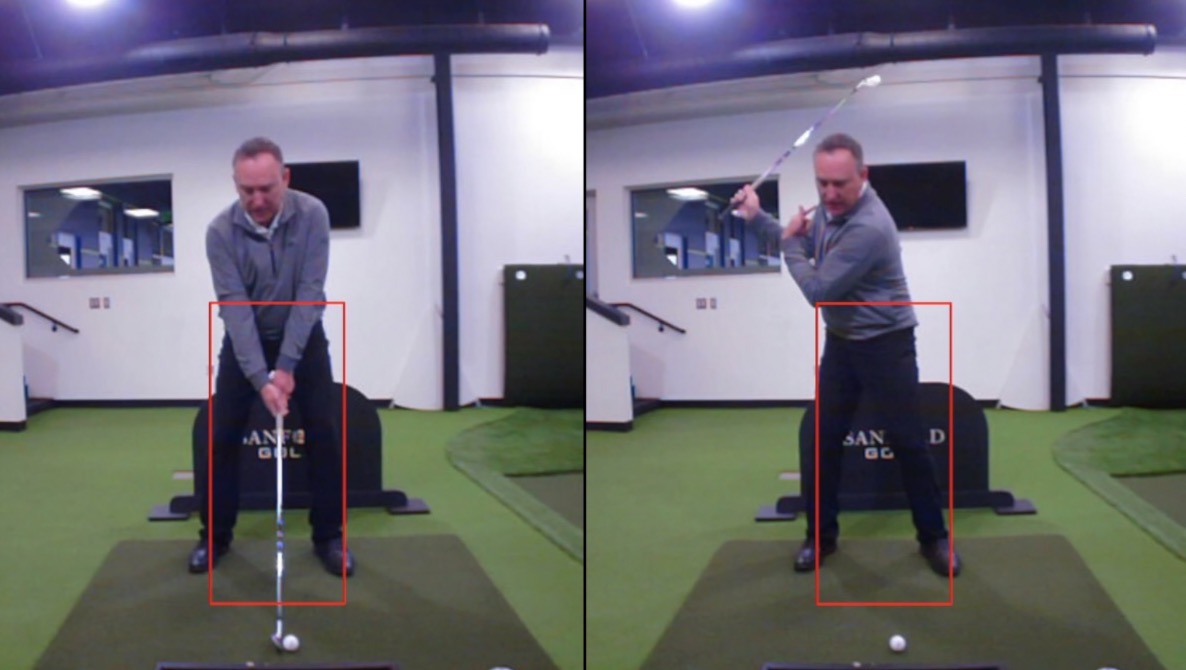
In short, lift your chin and let your head move from side to side. The movement that feels natural is the one that’s going to help your iron shot.
Myth #2: Keep Your Lead Arm Straight
Has anyone ever told you a straight lead arm is the key for how to hit irons?
Odds are, you tried it and learned that 1) that hurts and 2) it doesn’t really help. This is because a straight arm is a locked arm, and anytime you lock a joint, you get (that’s right) tension.
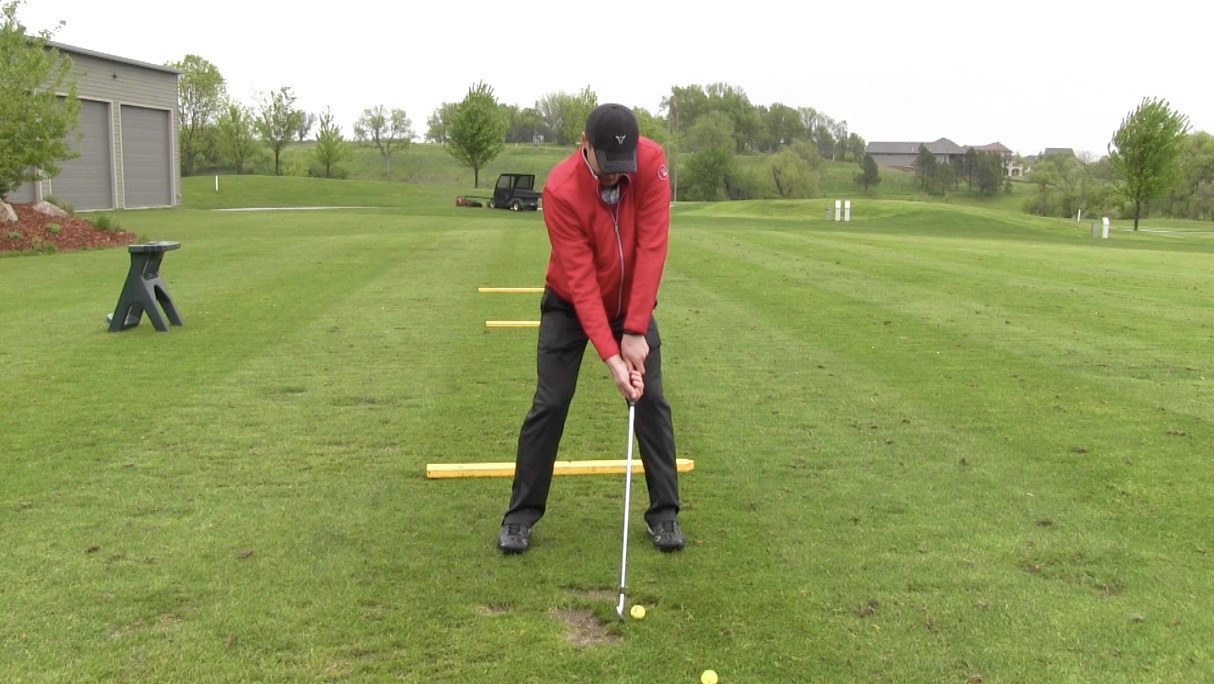
And when it comes to your lead arm specifically, that tension is not only going to create pain. It’s also going to limit the length of your backswing.
Trust me: a rigid lead arm is not a good setup.
Do This Instead
Just let that lead arm relax. Take a second right now to let your arms fall to your sides naturally. You feel that slight bend? That’s the amount of bend you want in your lead arm when you take your iron shots.
I learned a great drill for this from fellow golf coach Mike Bender. He emphasizes arm speed a lot in his instruction, and he taught me this simple trick for helping students generate more power with their arms.

All you have to do is take your iron set up and hit the ball using arms only. No rotation. Just feel your arms swing back and through: soft and relaxed.
Once you get the feel for it, add the turn and take your regular iron shot. You’ll be amazed how much more power you get with relaxed arms.
Myth #3: Flex Your Trail Knee/Restrict the Hip
This tip drives me crazy. If someone has told you to flex your trail knee and try to avoid turning the right hip, don’t listen.

Not only does this hinder movement; it creates lower back pain for a lot of golfers.
And back pain—as many of us know all too well—can ruin a round of golf and discourage you from playing as much as you’d like.
Do This Instead
Let your body move the way it wants to!
Release the trail knee and allow the hips to turn into your backswing. You’ll get a longer, stronger swing.
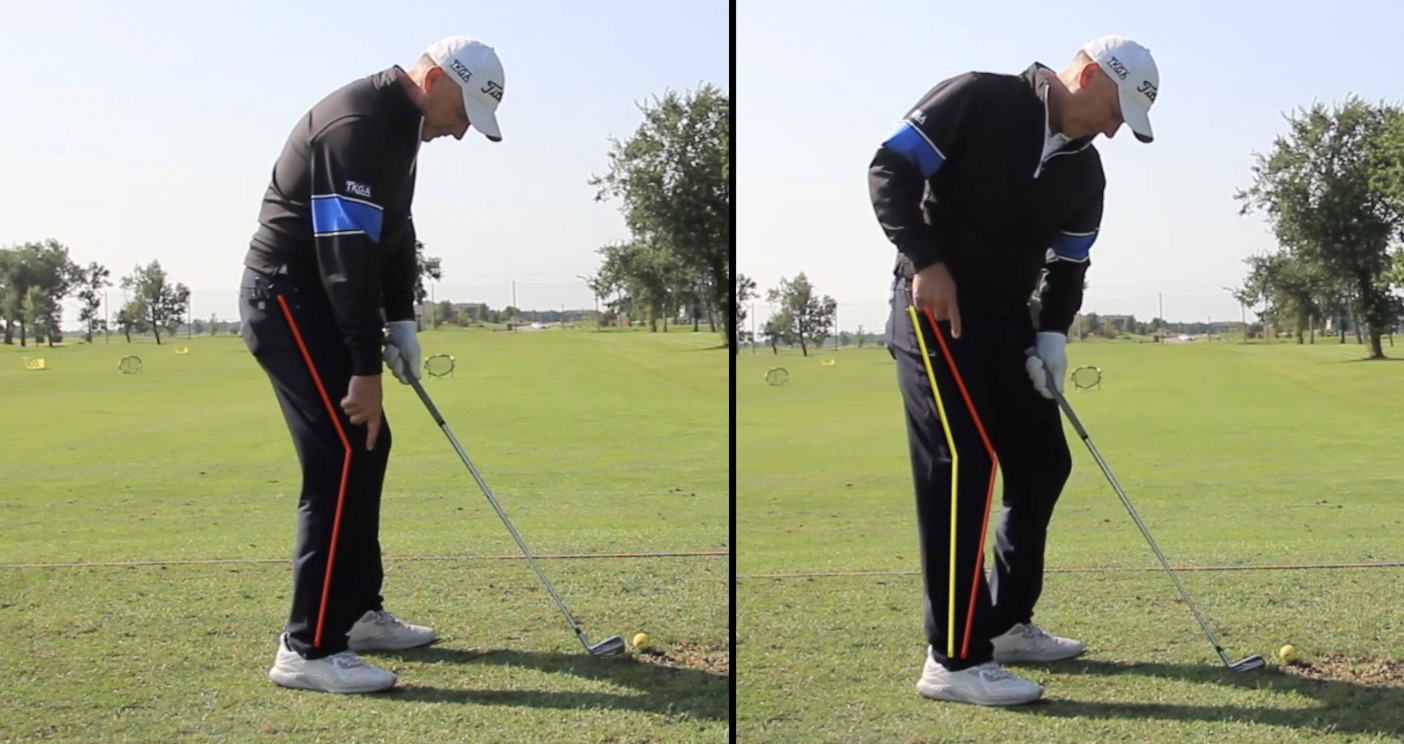
What Now?
You’re working with a lot of information now. You know the proper golf setup for irons. And you know the proper ball position in your stance depending on which iron’s you’re using. You also know which common tips to dismiss and how to get the best mobility in your golf swing.
Now we just have to put it all together.
How to Practice Hitting Your Irons
I’m going to wrap this all up for you by providing a clear checklist to help you nail your iron setup and golf swing. Then, I’ll provide a tip for proper finish position and a bonus drill to use the next time you’re at the driving range.
First, the recap.
How to Hit Irons: A Checklist
The next time you take an iron shot, check to make sure the following details are in place.
Short Irons
- Setup
- The ball is in the center of your stance
- It is aligned with the inner corner of your lead eye, the buttons/ zipper on your golf shirt, or slightly forward of your nose
- The handle of your club shaft is just slightly in front of the ball
- Your chin is slightly raised and your neck is relaxed
- You have a nice, relaxed bend in your lead arm
- Golf Swing
- On the backswing, allow the head to move away from the target, the trail knee to release, and the hips to rotate
- Keep the lead arm relaxed
- Pull the club handle down in the transition
Long Irons
- Setup
- The ball is just slightly forward of center in your golf stance
- It is aligned with the logo on your golf shirt or your lead ear
- The handle of your club shaft is just slightly in front of the ball
- Your chin is slightly raised and your neck is relaxed
- You have a nice, relaxed bend in your lead arm
- Golf Swing
- On the backswing, allow the head to move away from the target, the trail knee to release, and the hips to rotate
- Keep the lead arm relaxed
- Pull the club handle down in the transition
Now, the only thing left to do is finish the golf swing.
Bonus Tip: Good Finish Position
This is almost too easy to believe.
You should have good balance in your finish position. And there is one incredibly simple way to ensure this.
Finish your iron shot with your knees touching.
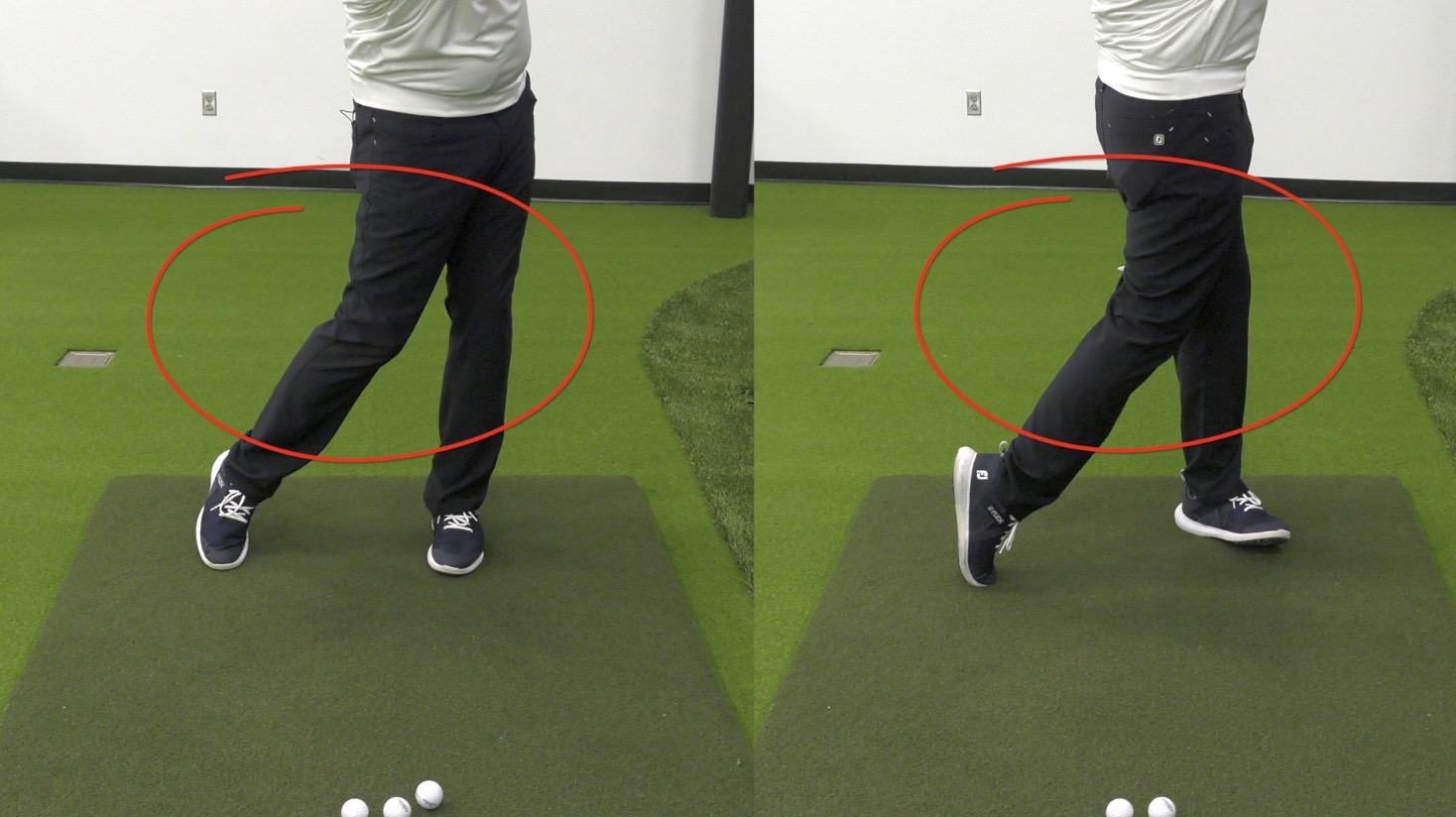
That’s it.
You see, when you take your swing with the intention of ending in this position, you get strong balance and excellent rotation. Your body naturally moves the way it should. And you see the results on your scorecard.
Before we wrap up, I want to introduce you to one more practice technique. This is one of my favorite drills.
A Drill for Practicing Iron Shots
I learned this from Jonathan Moore, a great strength and conditioning coach and former National Champion.
The steps are simple.
- Take your iron setup without the golf ball.
- As you swing the club back, step the trail foot back and behind your body so it’s perpendicular to your lead foot.
- Then step the trail foot back into place as you swing through.
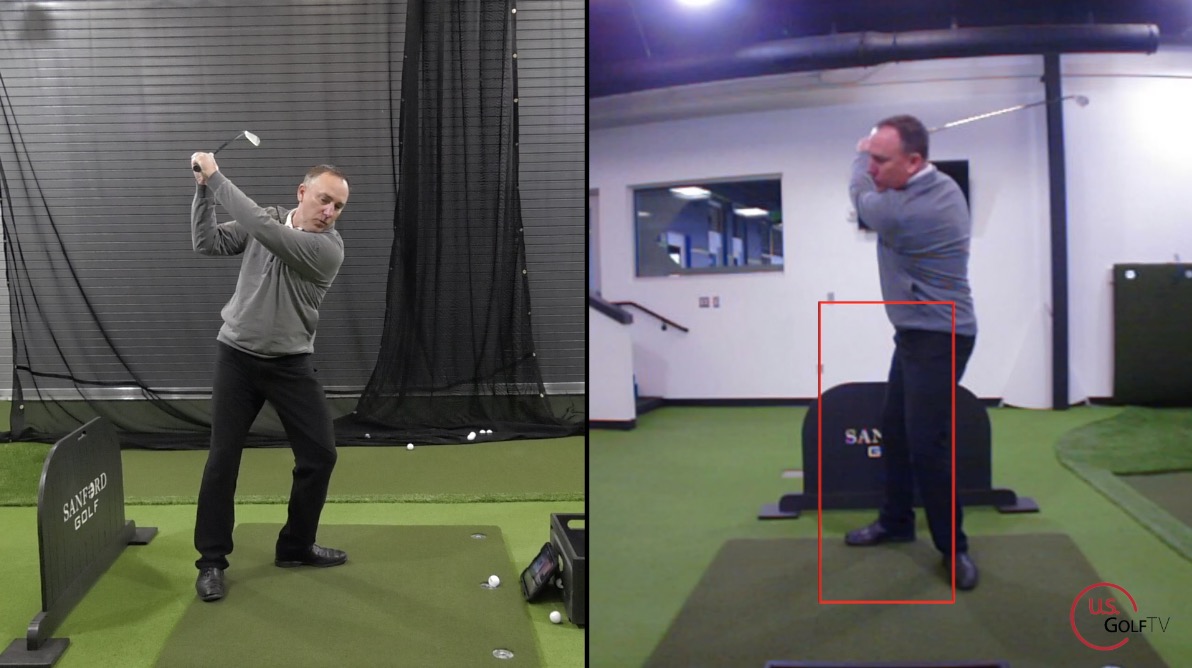
This drill helps you get a feel for strong rotation and natural movement in the body. I like to do a three-setter and then square up and hit a shot. (Three-setter means I drill the motion three times in a row.)
Make this a part of your regular driving range practice and I promise you will start to see it pay off in your iron shots.
What Do You Think?
Do you feel like you have more clarity on how to hit iron shots? Are there any questions you’d still like us to address? Do you disagree with any of these tips?
Please join us in the comments and tell us what’s on your mind!
For more in-depth golf tips, visit us at GreatGolfTipsNow.com. This golf instruction is completely free and packed with detailed advice to help you play better golf!


Thank you Todd,
Every instruction makes a little difference, some make significant improvements. I look forward to each new lesson and even better is going out to the range or course and practicing the drills and changes.
I am a firm believer in your simple approach.
Thanks again,
Keep them coming.
Kevin.
Kevin,
Thanks for the kind words..much appreciated! We agree, keep it simple, one step at a time….good stuff!
Todd,
I am a 5’6″ senior and I notice that when I assume a correct posture with my driver it lays on its heel with the toe of the club pointed skyward. Can I choke down to flatten the sole? What affect will it have on control an distance? Alternatively should I get the club shortened (1 1/2″)
Thanks in advance
Dan
Dan,
Great questions. The key to distance is first hitting the ball in the center of the face…center contact is king! Drivers have gotten very long these days and moving your hands down on the club an inch or so is a good idea IMO. Hope that helps…
Tod
I was wondering if you could do a segment on seniors with hip replacements to help them get help with hip rotation.Iam 77 years old and have had 3 hip replacements and currently a 11 handicap.I really enjoy your teaching lessons and keep up the good work.
Hi Allan, here is a great video we did on getting better rotation with limited mobility: https://youtu.be/9Ljz8ztw69Y
Let us know if it helps, and thanks for following our content!
this video says to pull the handle down early in transition. A more recent video about how to hit crisp iron shots on command says the opposite. I am confused.
Todd- Enjoy watching your golf videos. I have some issues with my golf swing that I’ve never had before. Arthritis in my fingers and toes, along with my neck and lower back. I’ve went to the medium Jumbomax grips as my fingers on my right hand especially ring finger is swollen and doesn’t bend. I now have a tendency to early extend as trying to stay in golf posture is painful. By doing this I tend to hit the ball toward the hosel. Also I might add that with my right hand position is now more strong than ever before. I’ve always been an inside to out swinger as that seemed to give me more extension and a draw. Any suggestions? I only play once a week on Saturday, but try to practice once or twice a week when weather permits. I live in Little Rock, AR, and play at Hot Springs Village.. I’ll be 68 in August and still work p/t..
Thanks for all you and many others do to help us that love the game.
Ron Harrington
Ron, thanks for posting and sharing your story. Get to see you still playing golf at 68! Awesome..Take a look at this video https://youtu.be/Z8LyPGy8Ycc
Todd, thx for very valuable tips. Believe me, its working and working fast.
Awesome to hear! We have more great content coming and on our YouTube channel https://www.youtube.com/channel/UCgz5-3igA0IfsyWGKTr6YKA
I am a senior RH golfers and I pull my iron shots to the left. Is that a problem with my swing plane? Am I coming in too steep? What can I do to fix this?
I don’t seem to do it with my driver . Your tips are terrific and really help
Thanks
Steve Hahn
Steve,
Coming over the top is generally the result of a poor transition. Check this out https://youtu.be/yP_uQBwh3NE
I wish I could hit my Irons, I was for a short time and then lost it, now I can’t hit with a 7 iron more than 60 yards. I cannot figure out what I am doing wrong. And maybe its cause I keep trying different tips and all of a sudden I lost my ability to hit my Irons, even my drives don’t go more than 100 yards. All sorts of tips out there. I just dont know any more. Im 62 and just beginning
Hi Sorry,
What I meant was that I hit my 7 iron only about 60 yards, When I actually hit it proper. Most of the time im either fat, thin, or topping the ball. Sooo frustrating 🙂
Thanks, may your tips will help.
Brian
Hi Todd,
Would you please compare and contrast the Mul and the Yuma so I can have some perspective as to which one to purchase.
Thanks!
Todd – love all your tips. My biggest issue with my irons that keeps haunting me is shifting my weight to my from foot, I have a bad tendency to lean back and can’t seem to break that habit (too much baseball growing up I guess) – can you suggest any tips or drills to help?
Art,
Thanks for the kind words. Here is a good video on the topic https://youtu.be/2NBoBafNzpM
You can also check out my latest book https://www.badliegolfbook.com/
Golf is hard, so many things to remember… So now I no longer think about my swing. I just line up, aim at my target, and hit the back of the ball. Does it work, it doesn’t matter. Sometimes it does, sometimes it doesn’t. It’s just more fun not worrying about it. My handicap is a little lower, but nothing to crow about.. But having said that, my handicap has not budged in the past 3 years, now it is on the move, but not significantly.
I practice as much as I can, but it’s for fun. I love hitting golf balls.. Especially chipping and putting. If’s fun. The more you do it, the better you get… I find technique has little to do with it, because every chip is different, different lie, different distance, slope… everything.. You just get better at it over time.
Todd I finally decided to try your system, so I purchased your book The Bad Lie. It’s been a week of practice and when I do it correctly the results are expressive. My big miss seems to be a big hook mostly with my woods so I’m going to need more practice but I like it. I’ll be trying my first round with this swing in a few days so wish me luck.
Jim,
Welcome to the Vertical Line Swing family! Great to hear you are making some progress. Are you on our email list? We do offer webinars on the system if interested.